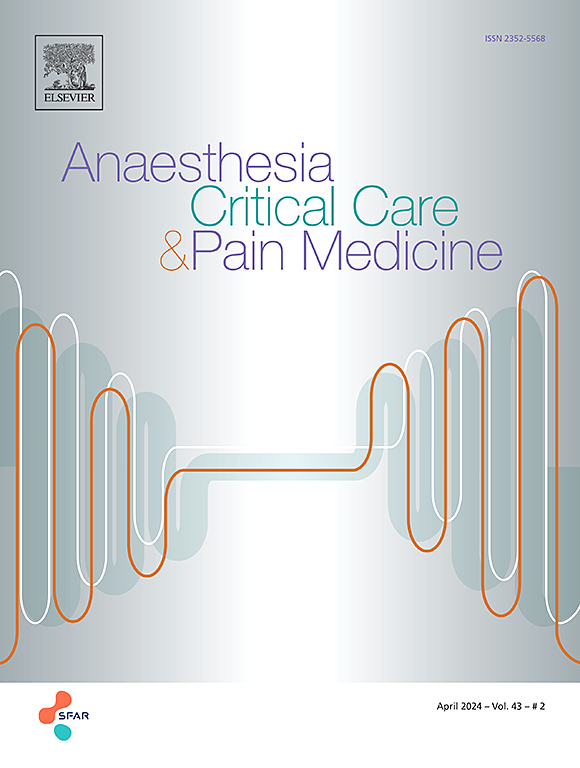胃超声在术前碳水化合物负荷中的实际意义及评价:746例术后增强恢复路径患者的回顾性分析。
IF 4.7
3区 医学
Q1 ANESTHESIOLOGY
引用次数: 0
摘要
背景:尽管术前碳水化合物负荷(PCL)通常被认为是安全的,但在实际临床环境中,PCL应用后通过胃超声评估胃状况的意义尚未得到充分的探讨。因此,本研究利用胃超声评估PCL术后的胃状态,并在一个大型手术队列中评估其在增强术后恢复(ERAS)方案下提高患者安全性的潜在作用。方法:回顾性分析2018年11月至2023年12月期间接受PCL并在ERAS方案下接受肝胆手术的患者。主要结局是胃内容物增加的发生率。次要结局包括PCL依从性、胃超声数据、禁食间隔、快速顺序插管(RSI)和误吸的发生率以及胃内容物增加的预测因素。结果:1187例患者中,ERAS方案内PCL应用的依从率达到88%,其中746例纳入最终分析。7.2%的病例空腹时间< 2小时。36例患者胃内容物增加的发生率为4.8%(95%可信区间[CI] 3.5-6.6%)。所有胃内容物增加的患者都进行了RSI,没有误吸的报道。多因素logistic回归发现BMI是胃内容物增加的唯一独立预测因子(OR 0.66, 95% CI 0.57-0.77)。结论:在ERAS方案下接受PCL的患者在临床实践中可能是安全的,不会增加胃内容物增加的风险。然而,个体差异和相关的危险因素需要考虑。报名:不适用。本文章由计算机程序翻译,如有差异,请以英文原文为准。
Practical significance and assessment of gastric ultrasound in preoperative carbohydrate loading: A retrospective analysis of 746 patients within the enhanced recovery after surgery pathway
Background
Although preoperative carbohydrate loading (PCL) is generally regarded as safe, the significance of assessing gastric status by gastric ultrasound after PCL application has not been adequately explored in real-world clinical settings. Therefore, this study evaluated gastric status after PCL using gastric ultrasound and its potential role in enhancing patient safety within a large surgical cohort under Enhanced Recovery After Surgery (ERAS) protocols.
Methods
We retrospectively analyzed patients who received PCL and underwent hepatobiliary surgery within ERAS protocol between November 2018 to December 2023. The primary outcome was the incidence of an increased gastric content. Secondary outcomes included PCL compliance, gastric ultrasound data, fasting intervals, the incidence of rapid sequence intubation (RSI) and aspiration, and predictive factors for increased gastric content.
Results
Of the 1187 patients, the compliance rate for PCL applications within the ERAS protocol reached 88%, with 746 patients included in the final analysis. Fasting hours duration < 2 h in 7.2% of cases. The incidence of an increased gastric content was 4.8% (95% confidence interval [CI] 3.5–6.6%), observed in 36 patients. RSI was performed in all patients with an increased gastric content, with no aspiration reported. Multivariate logistic regression identified BMI as the only independent predictor of increased gastric content (OR 0.66, 95% CI 0.57–0.77, P < 0.001).
Conclusions
Patients receiving PCL within the ERAS protocol may be safe in clinical practice without an elevated risk of having an increased gastric content. However, individual variability and associated risk factors need consideration.
Registration
Not applicable.
求助全文
通过发布文献求助,成功后即可免费获取论文全文。
去求助
来源期刊

Anaesthesia Critical Care & Pain Medicine
ANESTHESIOLOGY-
CiteScore
6.70
自引率
5.50%
发文量
150
审稿时长
18 days
期刊介绍:
Anaesthesia, Critical Care & Pain Medicine (formerly Annales Françaises d''Anesthésie et de Réanimation) publishes in English the highest quality original material, both scientific and clinical, on all aspects of anaesthesia, critical care & pain medicine.
 求助内容:
求助内容: 应助结果提醒方式:
应助结果提醒方式:


